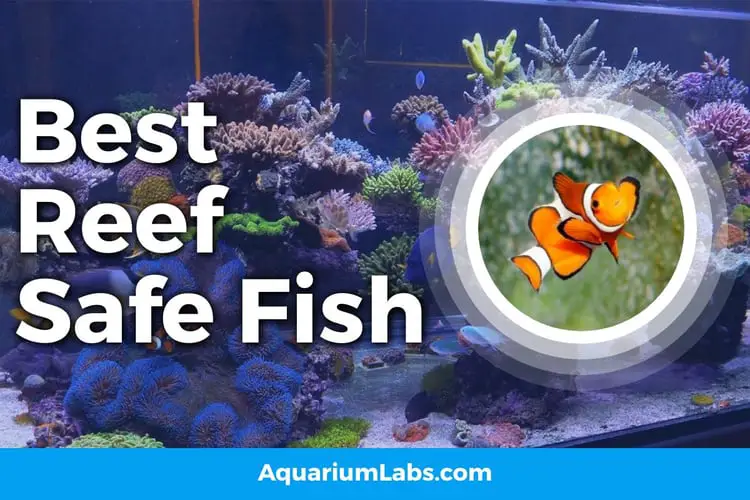We know the reef hobbyist fish selection struggle. Whenever reef fish keepers find themselves strolling through a local fish store, it’s always a struggle to determine which are the best reef safe fish. The last thing reef keepers want to do is introduce unfriendly reef fish to a peaceful saltwater aquarium fish tank.
Various reef fish species have different requirements to live comfortably. To ensure you choose reef safe aquarium fish, we’ve compiled a list of 15 of the best reef safe tank mates.
None of the fish species on this list need a reef tank size of more than four feet (except the Midas Benny), and none are known to damage corals in your aquarium.
For the most part, these reef fish tank inhabitants don’t have special dietary requirements, and they rarely behave aggressively even when competing for a mate.
Most of these species are also saltwater tank-bred, meaning they’re easy to keep in a home reef aquarium and very adaptable to different temperatures and water qualities.
Image | Fish Name | Max. Size | Min. Fish Tank | Link |
Clownfish | 3″ | 20 Gallons | ||
Banggai Cardinal | 3″ | 30 Gallons | ||
Pajama Cardinalfish | 4″ | 30 Gallons | ||
Orchid Dottyback | 4″ | 30 Gallons | ||
Black Molly | 3″ | 20 Gallons | ||
Royal Gramma | 3″ | 30 Gallons | ||
Mandarinfish | 3″ | 30 Gallons | ||
Blue Green Chromis | 3.5″ | 30 Gallons | Currently N/A | |
Bicolor Blenny | 4″ | 30 Gallons | ||
Firefish Goby | 3″ | 10 Gallons | ||
Six Line Wrasse | 3″ | 30 Gallons | ||
Watchman Goby | 3″ | 30 Gallons | ||
McCosker’s Flasher Wrasse | 3″ | 55 Gallons | ||
Midas Blenny | 6″ | 30 Gallons | ||
Azure Damselfish | 2.5″ | 30 Gallons |
15 Most Beautiful Reef Safe Fish for Saltwater Aquariums
The following 15 reef safe fish are capable of living harmoniously in a reef tank.
1. Clownfish

- Minimum tank size: 20 gallons
- Maximum fish size: 3”
- Temperament: Mostly peaceful
- Lifespan: 3 – 5 years
- Diet: Omnivorous
Star of the memorable Pixar movie Finding Nemo, the clownfish has become one of the best reef safe fish and is popular with reef aquarium owners the world over. The clownfish is easy to keep as long as you don’t mix two clownfish species in the same reef tank. The clownfish’s diet consists mostly of plankton, small crabs and crustaceans, algae, and worms.
Related: The Many Types of Clownfish
The clownfish doesn’t need a mate to survive in a habitat. It will visit all the available space in your reef tank if kept by itself, and it will eat mostly dried, frozen, and fresh food offerings. The clownfish is a great beginner marine fish for a first-time aquarium owner.
2. Banggai Cardinalfish
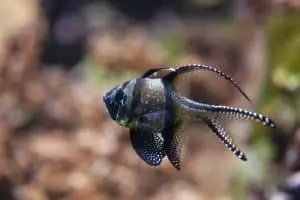
- Minimum tank size: 30 gallons
- Maximum fish size: 3”
- Temperament: Mostly peaceful
- Lifespan: 2.5 – 3 years
- Diet: Carnivorous
The Banggai Cardinalfish’s striped and slightly spotted appearance can bring a different feel to any reef or tank. This mostly peaceful reef fish will not dart around your tank like the clownfish. However, you should not mix pairs that have not been mated in one tank, especially when there’s little territory to fight over.
Their diet consists mostly of small crustaceans or copepods like krill. They are slow to take to manufactured flakes and pellets. However, once they get used to you feeding them, they will eat at your designated feeding times.
3. Pajama Cardinalfish
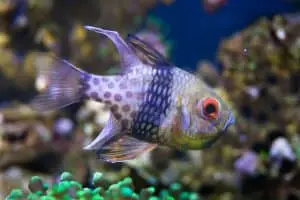
- Minimum tank size: 30 gallons
- Maximum fish size: 4”
- Temperament: Mostly peaceful
- Lifespan: 4 – 5 years
- Diet: Carnivorous
The Pajama Cardinalfish is a hardy species that originate from the Great Barrier Reef and can be found across the Western Pacific seaboard. This saltwater aquarium fish is nearly identical to the Banggai Cardinal when it comes to breeding possibilities, and it will swim along with the other fish in your reef tank. Some aggression has been observed when Cardinalfish split off into pairs while breeding, but in a big enough tank, aggression shouldn’t be a problem.
Like the Banggai, the Pajama Cardinalfish is slow to accept manufactured flakes or frozen food. Offer defrosted Mysis shrimp or brine shrimp to start, and then mix in increasing servings of flakes.
4. Orchid Dottyback
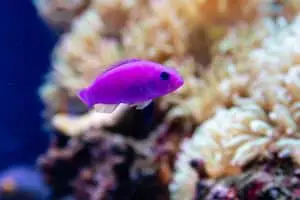
- Minimum tank size: 30 gallons
- Maximum fish size: 3”
- Temperament: Somewhat territorial
- Lifespan: 5 – 7 years
- Diet: Carnivorous
The Orchid Dottyback, also known as the Strawberry Dottyback and the Purple Dottyback, is mainly found in the warm Red Sea. Caring for them is easy, but you need to provide a few hiding spots in your tank so they don’t feel the need to defend their territory.
Coming in at 7 cm (about 2.8 inches) in a bright purple color, Orchid Dottybacks can be eaten by Lionfish, Eels, and Snappers, so avoid mixing them in a reef tank. Their diet consists of krill, brine shrimp, and other copepods. They will get used to frozen and flake foods at a moderate pace, so consistency is key.
5. Black Molly
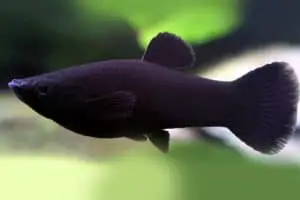
- Minimum tank size: 20 gallons
- Maximum fish size: 3”
- Temperament: Mostly peaceful
- Lifespan: 3 years
- Diet: Omnivorous
The Black Molly originates from Central and South America and is commonly seen along the coasts of Venezuela and the beaches of Mexico. The species’ hardiness and low maintenance requirements make it one of the most popular tank fishes for reef aquarium owners.
Ensure that the hard, alkaline water in your tank has good quality. Also, be sure that the sexes are in equilibrium. Females tend to get harassed when outnumbered by males, and males may develop aggression among themselves. Feed a mix of vegetables along with flakes, frozen bloodworms, and brine shrimp.
6. Royal Gramma
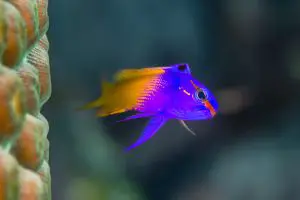
- Minimum tank size: 30 gallons
- Maximum fish size: 3”
- Temperament: Mostly peaceful
- Lifespan: 5 – 6 years
- Diet: Carnivorous
The Royal Gramma is one of the most vibrant and attractive species to feature in any reef aquarium. The fish are not easily infected by most diseases and are friendly to other fishes. Their hardiness, accessibility, and long lifespans make them an easy starter fish for aquarium beginners.
Keep your Royal Gramma in a reef tank with lots of hiding places so they can feel secure. Their diet is mostly plankton, and they will eat the occasional parasite picked from the skin of bigger fish. Always feed a varied diet even when switching to pellets and flakes.
7. Mandarinfish
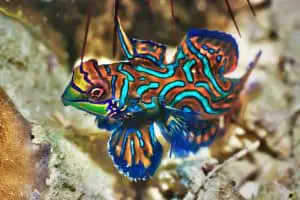
- Minimum tank size: 30 gallons
- Maximum fish size: 3”
- Temperament: Mostly peaceful
- Lifespan: 2 – 5 years
- Diet: Carnivorous
The Mandarinfish, also known as the Mandarin Dragonet, originates from the Pacific Ocean and has been found in many areas of Australia all the way to the Ryukyu Islands. Vibrant blue stripes make these fish colorful additions to any reef aquarium.
Mandarinfish spend their time hanging around on the floor of your tank, peacefully coexisting with other fishes. However, males can still fight among themselves, so they should be kept in pairs or on their own. They will eat frozen foods like Mysis shrimp or brine shrimp.
8. Blue Green Chromis

- Minimum tank size: 30 gallons
- Maximum fish size: 3.5”
- Temperament: Peaceful
- Lifespan: 8 – 15 years
- Diet: Omnivorous
The Blue Green Chromis (BCG) is found in the warm waters of the Pacific Ocean off Madagascar, Indonesia, Sri Lanka, and the Philippines, and in the Red Sea. They can live in lagoons and coral reefs, where they swim in schools that provide quite the visual feast during spawning season when their scales turn yellow.
The BCG is one of the most peaceful additions you can make to your reef tank, and this aquarium fish will leave your rocks, corals, and other fish alone. An omnivorous species, the BCG should be fed primarily meats like brine shrimp, krill, and Mysis shrimp.
9. Bicolor Blenny

- Minimum tank size: 30 gallons
- Maximum fish size: 4”
- Temperament: Peaceful
- Lifespan: 2 – 4 years
- Diet: Herbivorous
The Bicolor Blenny gets its name from its family, Blenniidae, and its two colors, blue and orange. The species needs a saltwater aquarium with big and small rocks to provide security. This fish loves to hide and perch, and it rarely causes damage to clams and corals unless it is underfed and begins feeding on fleshy parts and mantles.
Although peaceful toward most species, the Bicolor Blenny can pick fights with other blennies and dartfish. A plant-based diet is best, and frozen and dried blue-green algae are favorites. The Bicolor Blenny will help control the level of algae in your saltwater aquarium.
10. Firefish Goby
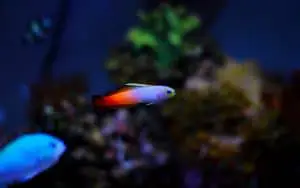
- Minimum tank size: 10 gallons
- Maximum fish size: 3”
- Temperament: Peaceful
- Lifespan: 3 – 4 years
- Diet: Omnivorous
The Firefish gets its name from the red streak that intensifies as it runs along the back and the fish ranks among the coolest reef safe fish. Originating from the Pacific and the Indian Ocean, Firefish are also found along the Maldives, Indonesia, and Africa. They will appear shy when you first put them in your saltwater aquarium, but they will be quite active later on, earning their moniker of “dartfish.”
Though peaceful neighbors to other aquarium fish, Firefish can fight among themselves. They thrive on a diet of frozen and meaty foods like Mysis shrimp, along with plankton and other copepods.
11. Six Line Wrasse
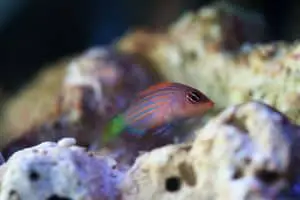
- Minimum tank size: 30 gallons
- Maximum fish size: 3”
- Temperament: Semi-aggressive
- Lifespan: 10 years
- Diet: Carnivorous
The Six Line Wrasse is a bright purple and yellow fish. Saltwater aquarium owners appreciate the fish’s hardiness and penchant for eating pests like bristle worms, flatworms, and pyramidellid snails. The Six Line Wrasse also loves cleaning fellow fishes by eating parasites off their scales.
In their natural habitat, Six Line Wrasses mostly consume small crustaceans, fish eggs, and mollusks. They are categorized as semi-aggressive because they will successfully compete with Mandarinfish for food from live rocks and will bully passive, introverted fishes like the Flasher Wrasse, Grammas, and Firefish.
12. Watchman Goby
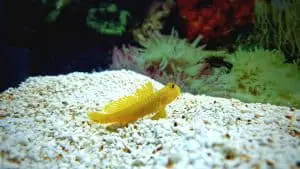
- Minimum tank size: 30 gallons
- Maximum fish size: 3”
- Temperament: Peaceful
- Lifespan: 3 years
- Diet: Carnivorous
The Watchman Goby, commonly known as the Yellow Shrimp Goby or the Yellow Prawn, is a battened-down security guard for its territory. This reef safe saltwater fish likes to sit and watch for competition around its burrow, which is an attitude it will bring to the saltwater aquarium. The goby works perfectly with its partner Pistol Shrimp in defending its territory while making sure they have ample food to eat.
The Watchman Goby will take a day or two to get used to a new feeding pattern but will eventually love Mysis shrimp, brine shrimp, and other frozen food and flakes.
13. McCosker’s Flasher Wrasse
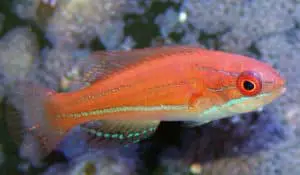
- Minimum tank size: 55 gallons
- Maximum fish size: 3”
- Temperament: Peaceful
- Lifespan: 3 – 5 years
- Diet: Carnivorous
The McCosker’s Flasher Wrasse originates from the western regions of the Pacific Ocean and the Indian Ocean and can be found in colorful communities throughout the world, including the Maldives, Africa, Bali, and Australia. The Wrasse will habitually inhabit the bottom of your tank and will swim among groups of other fish.
In general, this fish is very friendly and loves a big tank. At times, the Wrasse can be aggressive when competing for space with other fish that are eating plankton. The fish will thrive on brine shrimp, Mysis shrimp, mussels, and clams, though it also will like a helping of seaweed once in a while.
14. Midas Blenny
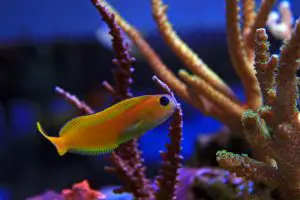
- Minimum tank size: 30 gallons
- Maximum fish size: 6”
- Temperament: Peaceful
- Lifespan: 5 – 8 years
- Diet: Omnivorous
Midas Blennies get their name from their fish family, Blenniidae, and their bright-to-deep gold color, as if they’ve been touched by King Midas himself. They thrive in big, spacious reef tanks. With the blue hues under their chins and their blue sclera, they are very attractive to watch. They’re one of the most beautiful reef safe fish you can own today.
If you plan on buying this saltwater fish, make sure your tank has some rocks because Blennies love perching and hiding among them. The Midas Blenny is generally peaceful but is known to nibble at Gobies and Firefish when confined in small spaces. A good diet consists of Mysis shrimp, brine shrimp, and blue-green algae.
15. Azure Damselfish (Kupang Damsel)
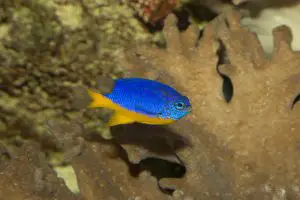
- Minimum tank size: 30 gallons
- Maximum fish size: 2.5”
- Temperament: Semi-aggressive
- Lifespan: 15 years
- Diet: Omnivorous
The Azure Damselfish originates from the western Pacific Ocean and the Indian Ocean and can be found off the coast of Indonesia and the northwest parts of Australia. When first added to your saltwater aquarium, the Damselfish might appear quite shy and passive, but later you will know why it’s called a dartfish.
The Azure Damselfish will love an aquarium with plenty of live rocks and decorations. Hardiness and tolerance for poor water quality make this fish a good choice for budding aquarium enthusiasts. However, the Azure Damselfish is classed as semi-aggressive because adults can be territorial against more introverted fishes.
A good diet consists mostly of Mysis shrimp, brine shrimp, and an assortment of frozen meats, with some dried seaweed now and then.
Related:

